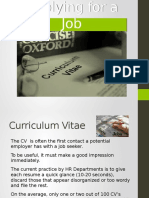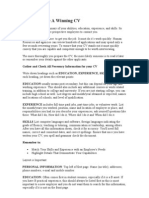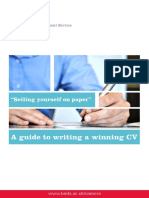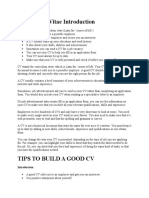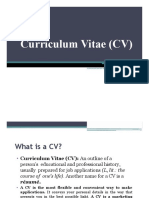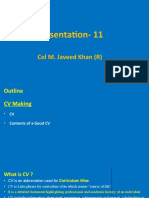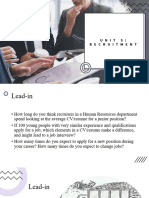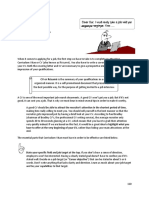0 ratings0% found this document useful (0 votes) 34 views6 pagesCV + Purpose and Techniques of Interview
CV + purpose and techniques of interview
Copyright
© © All Rights Reserved
We take content rights seriously. If you suspect this is your content,
claim it here.
Available Formats
Download as PDF or read online on Scribd
UA 17
fla!
CV Writing
, ACV (Curriculum Vita, which meuns course of fife in Latin) is un in-depth document that ean be laid out over
two or more pages and i! contains u high level of detail ubout your achievements, u great deal more thaw just
career biography. The CV covers your education ss well as any other accomplishments like publications,
awards, honors etc.
Differences: Ageoeeer LV Gre Resn7e
As stated, three major differences between CVs and resumes are the length, the purpose and the layout. A
resume is a brief summary of your skills and experience over one or two pages, a CV is more detailed und can
stretch well beyond two pages. The resume will be tailored to each position whereas the CV will stay put and
any changes will be in the cover letter.
, ‘A CV has a clear chronological order listing the whole career of the individual whereas a resume’s
information can be shuffled around to best suit the applicant. | would say the main difference between a
tesume and a CV is that a CV is intended to be a full record of your career history and a resume is a brief.
targeted list of skills and achievements.
Let's revise:
C.V ~ long, covers your entire career, static
Resume — short, no particular format rule
What to Include in a Curriculum Vitae
‘A curriculum vitae, commonly referred to as CV, is a longer (two or more pages), more detailed synopsis than a
resume. Your CV should be clear, concise, complete, and up-to-date with current employment and educational
information.
‘The following are examples of information that can be included in your curriculum vitae. The elements that
you include will depend on what you are applying for, so be sure to incorporate the most relevant information to
Support your candidacy in your CV. No matter whether you use a CV or resume, you need to thoroughly ¢
Gocument, Make sure there are no spelling or grammatical errors, Also make sure your format is uniform
for example, i you use bullet points in one job description, use bullet points in all your job descriptions
«Personal details and contact inform: "
+ Most CVs start with contact information and personal data but take care to avoid superfluous details,
such as religious affiliation, children's names and so on.
+ Education and qui fications.
Take care to include the names of institutions and dates attended in reverse order; PhD, Masters,
Undergraduate. ;
Work experience/employment history.
“The most widely aecepied sie of employment record is the chronological curriculum vitwe. Vout cane
ie entaanted in reverse dete oer satng with os! een. Achievement and responsibilities ited
histor Pr ore emphasi/inzomation should be [ut on mare resent obs. Its imporant to prone the
for cant of your resume so thal your most importint and relevant experience is listed first, with key
co nemplishments listed atthe top of each position
+ Skills.
Include comput
applied for.
‘Scholarships
er skills, foreign language skills, and any other recent training that is relevant (0 the role
OM me
‘Scanned with CamScanner�+ Training
+ Study abroad
+ Dissertations
+ Theses
+ Research experience
+ Graduate fieldwork
+ Teaching experience '
+ Publications
+ Presentations and lectures
* Awards and honors
nts, Fellowships, a id assistantships »
nical, computer, and language skills
onal licenses and certifications
+ Hobbies and Interes
Have Seve
al Versions of Your CV:Don't just write one CV and use it for every position you apply for. Have
targeted and focused versions of your eurritulum vitae and use them accordingly.
Keep it Short: Lpossible, try to keep your CV short and concise, Include summaries of your employment and
education, rather than lots of details, Use formal (no slang or abbreviations) and well-written language, writing
simply and clearly
What Not to Include: There is no need to include your photo, your salary history, the r
previous position, or references in your CV. References should be listed separately ancl
request
ison you left your
iven fo employers upon
How long should 1 GV Be?
A youd curriculum viae should ideally cover nu inure than two pages anid never sire than three, Aim
to ensure the coment is clear, structured, concise and relevant, Using bullet points rather than full sentences can
help minimize word usage. The typical resume should be printed in black ink on an A4 size white paper, with a
4 or 1 inch margin, all around. The font should be between 10 and 12, while the headings can be in 14. Use a
professional font, such as Times New Roman or Ariel, However, unprofessional looking fonts, such as Comic
‘Sans should not be used. Your name at the top of the CV can be in a larger font size than the rest of the CV.
What mistukes do candidat:s make on their GV?
One survey of employers found the following mistakes were most common
Spelling and grammar 56% of employers found this
Not tailoved 10 the job 21%
Length not right & poor work history 16%
Poor format and no use of bullets 11%
No accomplishments 9%
Contnet 8 email problems 87% |
Objective/profile was too vague 5%
vine 2%
Lying 2%
Having a photo 1%
phi
Chase a sensible email address!
Gone sagwey found that 76% of CVs with unprofessional email addresses a
tanoaifed yr orm a Ares that you should NOT emulate,
\
wored. Mere-are-some
‘Scanned with CamScanner�What is an interview?
An interview is a meeting between a job applicant and a representative of the company. The
meeting comes about because the company had a job available. People applied for the job. The
company needs to decide who to hire.
What is the Purpose of an Interview?
An interview is a two-way exchange, a conversation, in which both participants
have some goals.
The Interviewer wants to determine
* Can the candidate do the job?
+ Will the candidate fit in?
+ Is this the best candidate for the position?
The Interviewee wants to determine: >
* Do I want this job? Or
* Can I do this job?
+ Does this job offer me the opportunities I want for advancement or
experience?
To enhance your success at interviewing there are things you need to do before,
during and after the interview.
Before the Interview:
+ Read about the job/occupation.
+ Interview people in the department.
+ Build your network,
+ Practice interviewing ,
+ Dress for success
+ Visit the organization
+ Have an agenda, know what you want the interviewer to learn about you
+ Anticipate what questions will be asked
+ Know your Knowledge, Skills, Abilities and Accomplishments
+ Relate your KSAs to the position for which you are applying
+ Know who is interviewing you
+ Prepare and practice answers to typical questions
During the Interview:
+ RELAX!
+ Answer the questions using the “PROVE IT” Method
«+ Ask intelligent questions about the organization
+ Don’t volunteer negative information about yourself
+ Be honest
+ Have eye contact with the interviewer
+ Be believable, be yourself . .
+ Say positive things about your former supervisors and working conditions
« Find ways to let the interviewer know you are a team player
EE
Stationery
‘University
B
Beaute
GC Women
Scanned with CamScanner�After the Interview:
+ Evaluate the interview
© What questions were asked?
o What did you say that seemed to interest the interviewer?
0 Did you present your Knowledges, Skills and Abilities well? What did you forget to say?
o Did you get a commitment from the interviewer?
© Do you know what the next step is in the hiring process?
+ Write a thank you note to the interviewer
+ Follow up
Contact the interviewer for feedback
o Express your interest in the position
even after the position is filled
TECHNIQUES OF GOOD INTERVIEW
1. Do Your Research
\
Researching the company before the interview and learning as much as possible about its
services, products, customers and competition will give you an edge in understanding and
addressing the company's needs. The more you know about the company and what it stands for,
the better chance you have of selling yourself in the interview. You also should find out about,
the company's culture to gain insight into your potential happiness on the job.
2. Look Sharp >
Select what to wear to the interview. Depending on the industry and position, get out your best
interview clothes and check them over for spots and wrinkles. Even if the company has a casual
environment, you don't want to look like you slept in your outfit, Above all, dress for confidence.
If you feel good, others will respond to you accordingly.
3. Be Prepared
Bring along a folder containing extra copies of your resume, a copy of your references and paper
to take notes. You should also have questions prepared to ask at the end of the interview. For
extra assurance, print a copy of Monster's handy interview take-along checklist.
4.BeonTime ,
Never arrive late to an interview. Allow extra time to arrive early in the vicinity, allowing for
factors like getting lost. Enter the building 10 to 15 minutes before the interview.
5. Show Enthusiasm
A firm handshake and plenty of eye contact demonstrate confidence, Speak distinctly in a
confident voice, even though you may feel shaky.
Scanned with CamScanner�\
mM
6.Body Language of candidates
ees standing of the messages sent by the intervie
* Words alone - 7%;
* Voice tones - 38%;
~ Body language - 55%,
Non-verbal messages are much less likely to be under conscious control and are therefore harder
to disguise. They
are often difficult to interpret and care needs to be taken in analysing such
Messages €.g. a candidate may fold arms as he/she is cold, not necessarily because he/she is
being defensive.
7. Listen
One of the most neglected interview skills is listening, Make sure you are not only listening, but
also reading between the lines. Sometimes what is not said is just as important as what is said.
8. Answer the Question Asked
Candidates often don't think about whether they are actually answering the questions their
interviewers ask. Make sure you understand what is being asked, and get further clarification if
you are unsure,
mA A DADADADILILILALARAR
9. Give Specific Examples
One specific example of your background is worth 50 vague stories. Prepare your stories before
the interview. Give examples that highlight your successes and uniqueness. Your past behavior
can indicate your future performance.
10. Ask Questions
Many interviewees don't ask questions and miss the opportunity to find out valuable information.
The questions you ask indicate your interest in the company or job.
Scanned with CamScanner�11.Follow Up
Whether it's thi i -
the interviewer of ee {egular mail, the interview follow-up is one more chance to remind
luable traits j tt mi. .
chance o market youre it you bring to the job and company. Don't miss this last
Itis important to appear confident
Prepared to the best of
following these impo
yourself.
lent and cool for the interview. One way to do that is to be
your ability. There is no way to predict what an interview holds, but by
tant rules you will feel less anxious and will be ready to positively present
12. Thank Interviewer(s) in Person, by Email, and Postal Mail.
As you have already seen from previous tips, common courtesy and politeness go far in
interviewing; thus, the importance of thanking each person who interviews you should come as
no surprise. Start the process while at the interview, thanking each person who interviewed you.
Writing thank-you emails and notes shortly after the interview will not get you the job offer, but
doing so will certainly give you an edge over any of the other finalists who did not bother to send
thank-you’s.
Scanned with CamScanner





